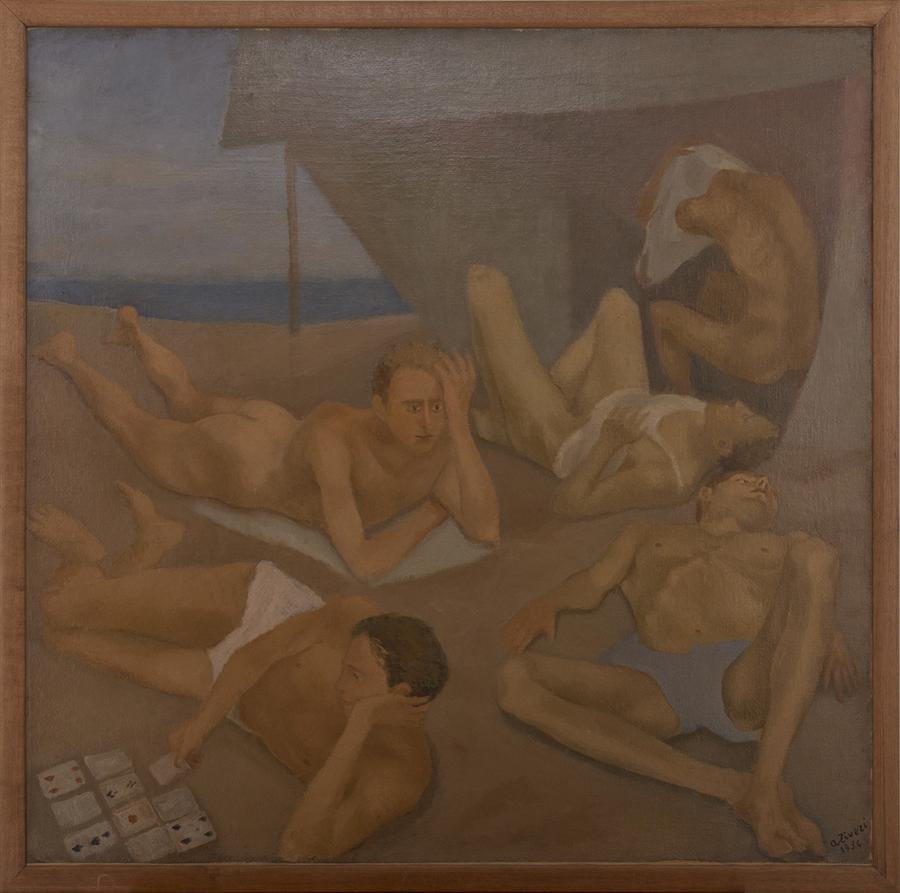La spiaggia, 1934
Alberto Ziveri (Rome 1908 – 1990)
La spiaggia
oil on canvas
1934
cm 125,5 x 120,5
Alberto Ziveri was a representative of the so-called “Scuola Romana“, a chronicler of urban landscapes and scenes of narrative realism such as this group of young athletic swimmers caught in a moment of repose on the banks of the River Tiber.
Over the years of training at the local high school for the arts, he was primarily interested in the modern painters active in Rome, such as Felice Casorati, Ardengo Soffici and Giorgio Morandi. Of these initial pieces, a few landscapes and portraits remain, prompted by the atmosphere of magical realism.
In the spring of 1928, he made his public debut when a few of his illustrations were displayed at the 94th Exposition of Fine Arts of the Società Amatori e Cultori. This was the year he discovered and was struck by the tonal painting of Piero della Francesca, that would accompany him for the duration of his artistic career, and the works of Parmigianino and Correggio.
After high school, he attended the Scuola Libera del Nudo.
Over the course of the 1930s, he began to intensify his participation in exhibitions.
In the 1935-36 academic year, he began teaching drawing and decorative painting at the Royal Industrial Artistic Museum of Rome, which later became the Istituto Statale d’Arte, where he taught until 1963.
His first solo exhibition was in February 1936. That same year, he participated in the 20th Venice Biennale, together with a group of young Roman painters. This was his first time participating in the Biennale, an event he would from then on attend regularly, much like the Rome Quadriennale.
In 1937, he travelled abroad for the first time, to Paris; from there he continued his journey of study to Belgium and the Netherlands. Visiting the museums of these countries, he was struck by the works of the 17th-century Dutch and Flemish masters, the Romanticism and Realism of 19th-century France, and Goya’s “Black Paintings”. Upon his return, his paintings took a significant and unequivocal turn: the delicate tonal harmonies gave way to works bursting with compactness, identifiable by rich oily colours and a robust use of chiaroscuro, accentuated to give a greater sculptural emphasis to the forms, with subjects often inspired by a crude form of realism.
In 1939, he moved into a studio on the top floor of a building at No. 59, Via Santa Maria dell’Anima, adjacent to Piazza Navona, from which he would work for the rest of his life.
After the end of the Second World War, he took up teaching again, began increasing his participation in exhibitions in Italy and abroad, and won numerous prizes.
In 1946, he had a solo exhibition at Rome’s National Gallery, featuring 27 paintings and 16 engravings. His self-taught engraving work accompanied his painting work like an intimate journal from the 1920s, but starting in the post-war years, Ziveri began to exhibit it on the biggest stages.
In the 1950s, he participated in collective exhibitions of Italian art in Greece, Japan, the United States, Turkey, as well as Germany, Russia and Slovenia.
In the 1960s, he cemented his status as one of the great masters of realism. Meanwhile, when it came to his teaching career, he moved into teaching at the academies, finding fulfilment in his relationships with his students, who he encouraged to always perform real life drawing. From 1963 to 1966, he taught decorative art at the Accademia di Belle Arti in Naples. In 1967 he was appointed chair of painting at Palermo, and from 1969 until his retirement in 1979, he was head of painting at the Academy of Fine Arts in Rome.
In 1963, he was elected as a member of the Accademia di San Luca, and the year after, the illustrious historian and art critic Roberto Longhi introduced his anthology of recent works: the exhibition reinforced his status as the leading Italian painter of reality.
In the 1970s, he enjoyed his firmly established fame: he was elected a member of the Accademia Pontificia dei Virtuosi at the Pantheon and the Accademia del Disegno in Florence, with numerous solo exhibitions. Ziveri’s reputation was definitively cemented in the 1980s.
